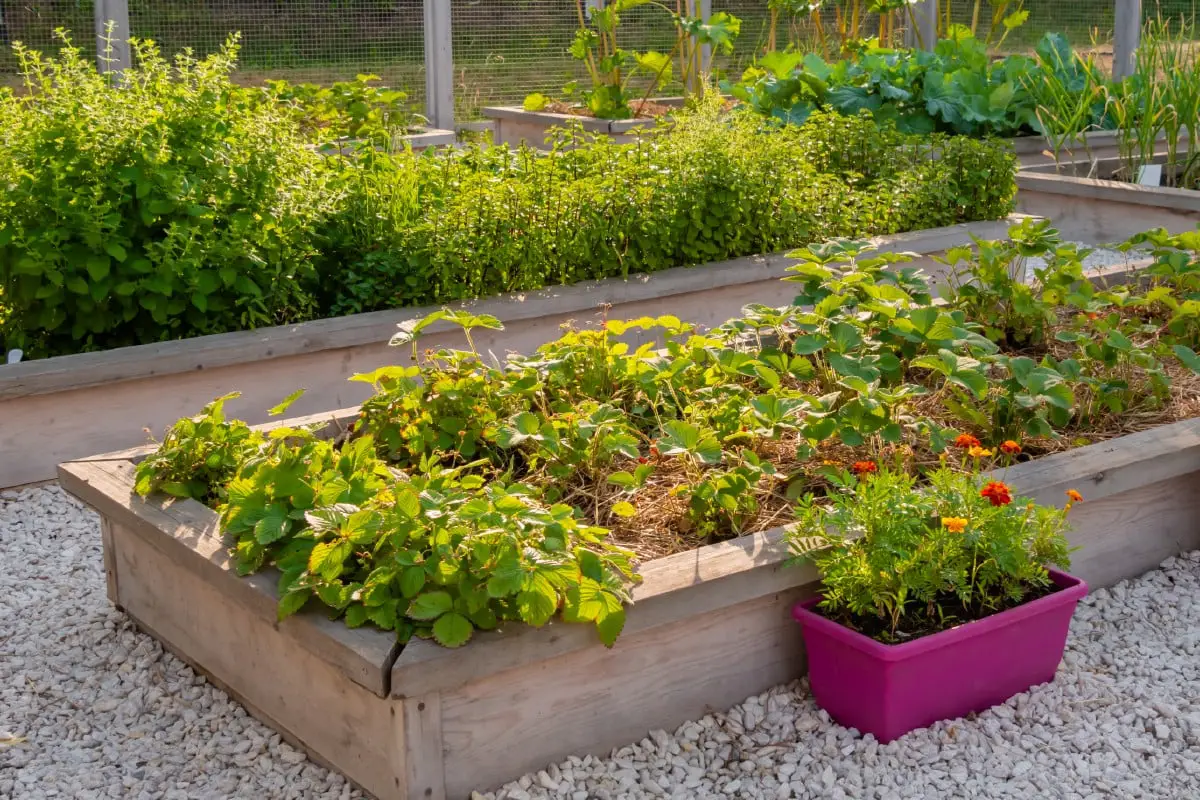In this article, you will learn the step-by-step process of planting strawberries in a raised bed. By utilizing a raised bed, you can optimize the growing conditions for this delicious fruit, ensuring a bountiful harvest. From selecting the right site to preparing the soil, choosing the appropriate strawberry varieties, and planting and caring for them, this guide will provide you with all the necessary knowledge to successfully cultivate strawberries in your very own raised bed. So, let us now embark on this journey of creating a thriving strawberry patch and relish the satisfaction of growing your own fresh, juicy strawberries.
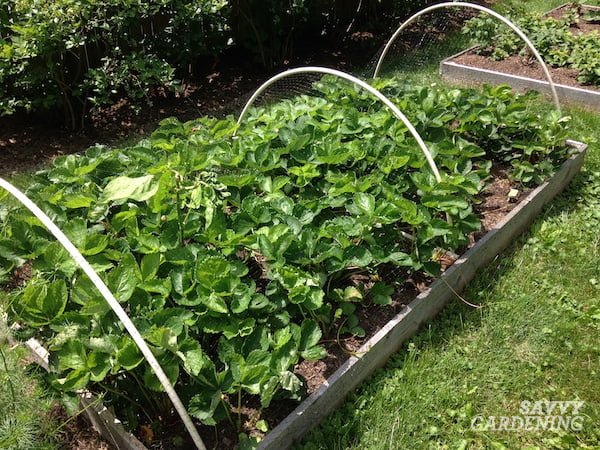
Choosing the Right Location
Choosing the right location for your strawberry raised bed is crucial for the success of your plants. Here are some factors to consider when selecting the perfect spot:
Consider the Sunlight
Strawberries thrive in full sun, so it’s essential to choose a location that receives at least 6-8 hours of direct sunlight each day. This abundant sunlight ensures proper photosynthesis, leading to healthy growth and abundant fruit production. Avoid shaded areas or spots that are blocked by tall trees or structures, as they can inhibit sunlight exposure and hinder the plants’ development.
Ensure Good Drainage
Strawberries prefer well-draining soil, as excessive water can lead to root rot and other issues. Evaluate the drainage capacity of the chosen area by observing how water accumulates after rainfall. If the water tends to pool or takes a long time to drain, it may not be suitable for strawberry plants. To improve drainage, you can consider incorporating organic matter or using raised beds to elevate the growing area.
Optimal Soil pH
Strawberries thrive in slightly acidic soil, with a pH range of 5.5 to 6.5. Before planting, it’s important to test the soil pH using a kit available at garden centers or through soil testing services. If the pH is too high, you can lower it by adding elemental sulfur or agricultural sulphur. Conversely, if the pH is too low, limestone or agricultural lime can be added to raise it to the optimal range. Maintaining the ideal soil pH ensures that the plants can absorb the necessary nutrients for healthy growth and fruit production.
Preparing the Raised Bed
Once you have chosen the perfect location for your strawberry bed, it’s time to prepare it for planting. Here are the steps involved in preparing a raised bed:
Clear the Area
Start by clearing the selected area of any weeds, grass, or debris. Clean the space thoroughly, ensuring that there are no remnants of plants or potential sources of pests and diseases. Clearing the area allows the strawberry plants to establish themselves without competition for nutrients and reduces the risk of disease transmission.
Build or Buy a Raised Bed
Raised beds provide several advantages for growing strawberries, including improved drainage, better soil control, and reduced weed growth. You can either build your own raised bed using materials like wood or bricks, or purchase pre-made raised bed kits from garden supply stores. When constructing or purchasing a raised bed, consider its dimensions, ensuring that it is wide and deep enough to accommodate the desired number of strawberry plants.
Add Supportive Structures
Strawberry plants benefit from the support of trellises or cages, especially for varieties with trailing growth habits. Add trellises or cages to your raised bed before planting the strawberries. This helps to keep the plants upright, prevents the fruit from touching the ground, and facilitates better air circulation, reducing the risk of disease. Evaluate the growth habits of the strawberry varieties you are planting to determine the appropriate type and height of support structures.
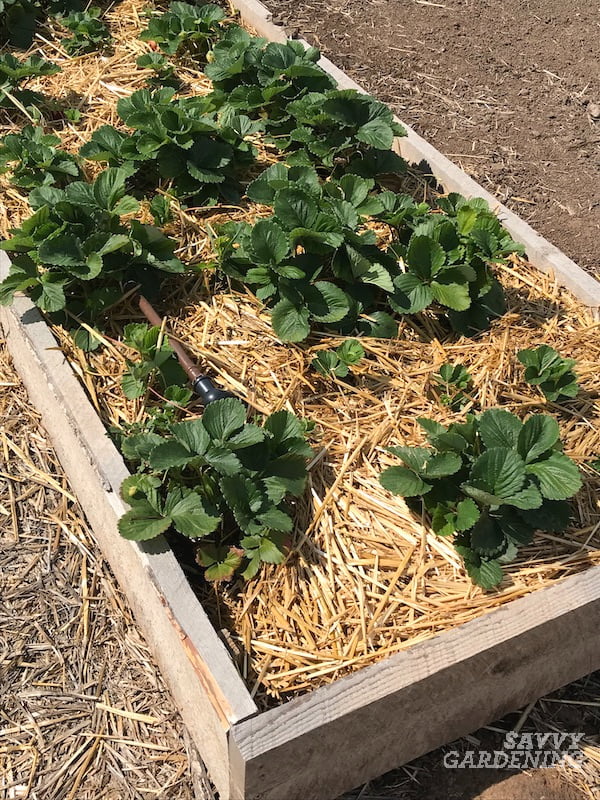
Selecting Strawberry Varieties
Choosing the right strawberry varieties is essential to ensure successful growth and a bountiful harvest. Consider the following factors when selecting which varieties to plant:
Determinate vs Indeterminate
Strawberry plants are classified as either determinate or indeterminate. Determinate varieties produce a single large crop of strawberries over a short period, typically in early summer. Indeterminate varieties, on the other hand, produce fruit continuously throughout the growing season. Consider your preference and intended use of the strawberries when deciding between determinate and indeterminate varieties.
June-bearing vs Everbearing
June-bearing varieties produce a concentrated harvest of strawberries in late spring or early summer. These varieties are favored by many growers for their large, flavorful fruit. Everbearing varieties, as the name suggests, produce multiple harvests throughout the growing season. If you enjoy a steady supply of strawberries over a more extended period, everbearing varieties may be a better choice for you.
Consider Climate and Growing Season
Strawberries have different climate preferences, and it’s important to select varieties that are well-suited to your local climate and growing season. Some varieties thrive in cooler climates, while others are better suited for warmer regions. Consider the average temperatures and frost dates in your area to ensure that you choose varieties that can withstand the climatic conditions.
Purchasing Strawberry Plants
Once you have decided on the strawberry varieties you want to grow, it’s time to purchase the plants. There are a few options for acquiring strawberry plants:
Buying Bare-Root Plants
Bare-root plants are dormant, with their roots exposed and wrapped in moist material. They are typically sold in bundles and are more cost-effective compared to potted plants. When purchasing bare-root plants, look for those with healthy, white roots and firm crowns. Avoid plants with dried or shriveled roots.
Choosing Potted Plants
Potted strawberry plants are already established in containers and can be transplanted directly into your raised bed. This option allows for more flexibility in planting time, as potted plants can be purchased and planted throughout the growing season. Choose plants with healthy foliage, compact root systems, and no signs of diseases or pest damage.
Ordering Online
If you have specific strawberry varieties in mind that may not be readily available at local garden centers, you can consider ordering plants online. Many reputable nurseries offer a wide selection of strawberry plants that can be shipped directly to your doorstep. When ordering online, ensure that you are purchasing from a reputable source, and consider the shipping timeline to ensure the plants arrive in good condition.
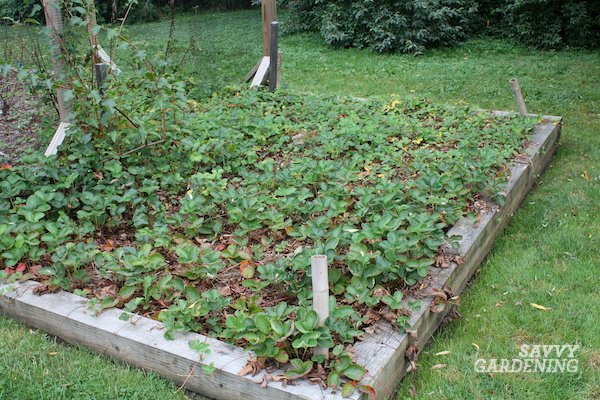
Soil Preparation
Proper soil preparation sets the foundation for healthy strawberry plants. Here are the steps to prepare the soil in your raised bed:
Remove Weeds and Grass
Before planting your strawberries, it’s important to eliminate any existing weeds or grass in the raised bed. Weeds compete with the strawberry plants for nutrients, sunlight, and water, which can hinder their growth and productivity. Use a garden fork or shovel to remove the weeds, ensuring you remove the entire root system to prevent regrowth.
Loosen and Amend the Soil
After removing the weeds, loosen the soil in the raised bed by gently cultivating it with a garden fork or tiller. This helps improve aeration and ensures that the roots can penetrate the soil easily. If the soil is heavy clay or lacks organic matter, incorporate well-rotted compost or aged manure to improve its structure and nutrient content. Work the amendments into the top few inches of soil.
Improve Drainage
To further improve drainage in your strawberry bed, consider adding organic materials like perlite or vermiculite. These materials help to create air pockets in the soil, allowing excess water to drain more efficiently. Additionally, incorporating coarse sand or small gravel can also aid in improving drainage. Avoid materials with a high salt content, as this can have detrimental effects on strawberry plants.
Planting the Strawberries
Now that your raised bed and soil are prepared, it’s time to plant your strawberry plants. Follow these steps to ensure proper planting:
Digging Holes
Using a trowel or garden shovel, dig individual planting holes in the prepared soil. The holes should be wide and deep enough to accommodate the entire root system of each strawberry plant. Space the holes according to the recommended spacing for the specific variety you are planting.
Spacing and Depth
Proper spacing is crucial to ensure adequate airflow and prevent overcrowding, which can lead to disease and pest issues. The recommended spacing between strawberry plants varies depending on the variety and growth habit. Generally, space the plants 12-18 inches apart within rows and maintain a distance of 24-36 inches between rows. As you place each plant into the hole, ensure that the crown is level with the soil surface.
Placing the Plants
Gently place the strawberry plants into the prepared holes, positioning them in a way that their roots are spread out and not folded or damaged. Backfill the holes with soil, gently firming it around the roots to ensure good soil-to-root contact. Avoid burying the crowns too deeply, as this can lead to rotting or other issues.
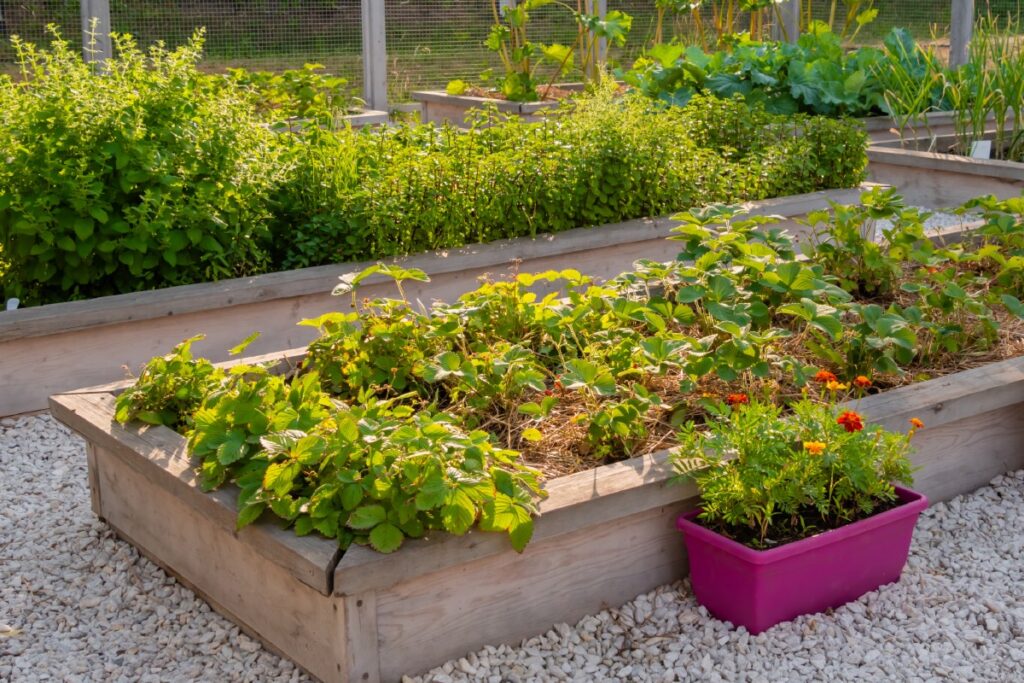
Mulching and Watering
Mulching and watering are essential for maintaining optimal soil moisture levels and promoting healthy strawberry growth. Follow these guidelines for mulching and watering your strawberry plants:
Applying Mulch
Apply a layer of organic mulch around the base of the strawberry plants, leaving a small space around the crown to prevent rotting. Organic mulch, such as straw, wood chips, or shredded leaves, helps retain soil moisture, suppress weed growth, and insulate the roots from extreme temperatures. Aim for a thickness of 2-4 inches, taking care not to bury the crown or foliage.
Watering Needs
Strawberries require consistent and adequate moisture to thrive. After planting, ensure that the soil is evenly moist, but not waterlogged. Monitor the moisture level regularly and water the plants when the top inch or two of soil feels dry. Deep, infrequent watering is more beneficial than frequent light watering, as it encourages the development of deeper roots. Water in the morning or early evening to minimize evaporation loss.
Drip Irrigation vs Overhead Watering
While there are various irrigation methods available, drip irrigation is often preferred for strawberry plants. Drip irrigation delivers water directly to the soil, minimizing evaporation and reducing the risk of foliar diseases. Overhead watering can still be used but should be done carefully to avoid wetting the foliage excessively. If using overhead watering, water early in the day to allow the foliage to dry before evening.
Fertilizing the Plants
Proper fertilization provides essential nutrients for strawberry plants, promoting vigorous growth and bountiful fruit production. Consider the following guidelines for fertilizing your strawberry plants:
Feeding Schedule
Strawberry plants should be fertilized throughout the growing season to ensure optimal nutrient uptake. Start by applying a balanced fertilizer at planting time, following the recommended dosage on the product label. After the initial application, feed the plants every 4-6 weeks during the growing season. Cease fertilization in late summer or early fall to allow the plants to prepare for dormancy.
Choosing Organic or Synthetic Fertilizer
The choice between organic and synthetic fertilizers depends on your preferences and gardening philosophy. Organic fertilizers, such as compost, aged manure, or fish emulsion, provide slow-release nutrients and improve soil structure. Synthetic fertilizers offer precise nutrient ratios and faster results. Whichever option you choose, ensure that the fertilizer is formulated specifically for strawberries and follow the manufacturer’s recommendations.
Avoiding Over-Fertilization
While proper fertilization is vital, over-fertilization can lead to nutrient imbalances, excessive vegetative growth, and reduced fruit production. Carefully measure and apply the recommended amount of fertilizer, avoiding the temptation to apply more in the hopes of obtaining better results. Regularly monitor the overall health and growth of the plants to ensure that they are receiving the necessary nutrients without being overwhelmed.
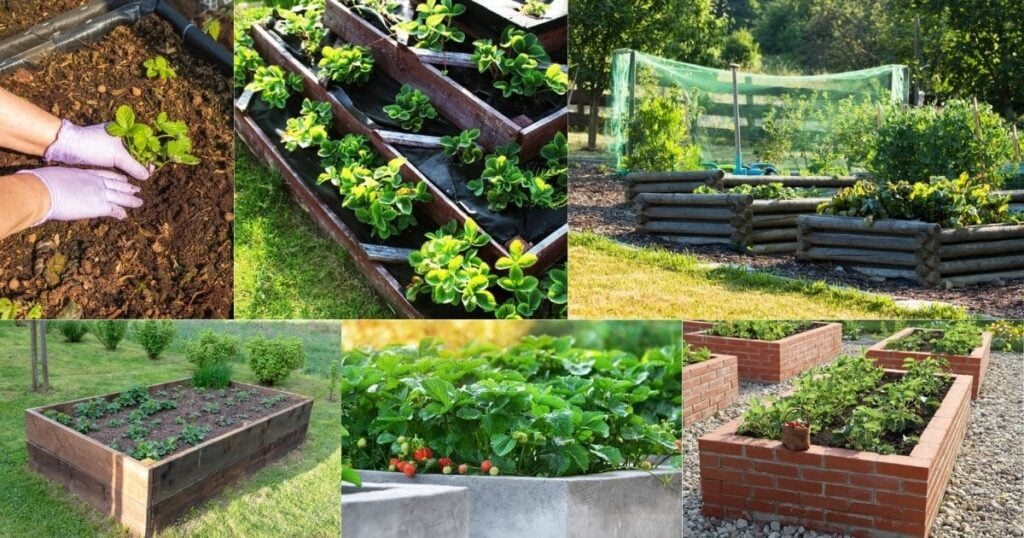
Protecting from Pests and Diseases
Strawberries are susceptible to various pests and diseases, which can hinder their growth and reduce fruit quality. It’s important to implement preventive measures and promptly address any issues that arise. Consider the following guidelines for protecting your strawberry plants:
Identify Common Pests and Diseases
Familiarize yourself with common pests and diseases that affect strawberries in your region. Some common pests include aphids, slugs, snails, and strawberry root weevils. Diseases, such as powdery mildew, gray mold, and leaf spot, can also impact strawberry plants. Regular inspection and monitoring are essential for early detection and timely intervention.
Natural Remedies and Chemical Controls
For organic gardeners, there are several natural remedies that can help control pests and diseases. Techniques like handpicking pests, introducing beneficial insects, and using homemade sprays made from ingredients like neem oil or garlic can help manage infestations. If necessary, chemical controls approved for strawberry plants can be used, following the instructions on the product label. Be mindful of potential environmental impacts and always prioritize the health of your plants and surrounding ecosystem.
Regular Inspection and Monitoring
Frequent inspection of your strawberry plants allows you to identify pest or disease problems early on and take appropriate action. Inspect the foliage, stems, and fruits regularly, checking for signs of damage, discoloration, or any abnormal growth. Monitor any changes in the appearance or behavior of the plants, such as wilting or stunted growth. Timely intervention can prevent the spread of pests and diseases and minimize potential damage.
Proper Pruning and Training
Pruning and training your strawberry plants help promote better air circulation, prevent overcrowding, and improve fruit quality. Follow these guidelines for proper pruning and training:
Removing Runners
Strawberry plants produce runners, which are long, horizontal stems that emerge from the base of the plant. While runners allow for vegetative propagation, they can also result in overcrowding and reduced fruit production. Regularly remove excess runners by cutting them off at the base or transplanting them to create new plants if desired. This allows the mother plant to focus its energy on fruit production.
Encouraging Aeration and Sunlight
To prevent disease and ensure optimal growth, it’s important to maintain good aeration and sunlight penetration within the strawberry bed. Remove any excess foliage or suckers that block airflow or shade the plants. Prune back any dead or diseased leaves, stems, or runners promptly to prevent the spread of infection. Regularly thinning out the plants ensures that each individual plant receives sufficient light, enhancing fruit development.
Training the Plants
Depending on the variety and growth habit, you may need to train your strawberry plants to grow in a specific manner. For trailing or vining varieties, secure the stems to trellises or cages to keep them upright and prevent them from sprawling onto the ground. This improves air circulation, reduces the risk of soil-borne diseases, and makes harvesting easier. For compact or bushy varieties, occasional pruning to maintain a neat and open shape may be sufficient.
In conclusion, planting strawberries in a raised bed requires careful consideration of several factors, from choosing the right location to maintaining proper pruning and training techniques. By following the guidelines outlined in this article, you can establish a successful strawberry bed that yields a bountiful harvest of delicious, homegrown strawberries. Remember to monitor the health of your plants, provide adequate care, and address any issues promptly to ensure their continued growth and productivity. Happy strawberry gardening!
